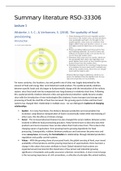Summary literature RSO-33306
Lecture 1
Wiskerke, J. S. C., & Verhoeven, S. (2018). The spatiality of food
provisioning.
Introduction
For many centuries, the locations, size and growth rate of cities was largely determined by the
amount of food and energy their rural hinterland could produce. The spatial proximity relations
between specific foods and city began to fundamentally change with the introduction of the railway
system, since food could now be transported over long distances in relatively short time. Following
this, spatial proximity relations between cities and agricultural production rapidly became weaker,
since with the introduction of new technologies (like airplanes, frozen transport and storage and
processing of food) the shelf life of food has increased. The growing apart of cities and their food
systems has changed their relationship in multiple ways - we can distinguish 3 spheres of changing
relationships:
Spatial – For many food items, the distance between production and consumption has
increased. Long-distance transportation of food is economically viable while externalizing all
other costs, like the effects of climate change.
Social – The increased physical distance has also changed the social relations between actors
involved in different food provisioning practices. Many farmers have no idea who eats their
products and most consumers have no idea where their food comes from. This is due to the
changing nature of agriculture: from growing food to growing ingredients for food
processing. Consequently, relations between producers and consumers become more and
more anonymous, increasing the formalization in relationships through detailed production
regulations and quality control systems.
Values – With the growing share of processed foods, the global sourcing of food, year-round
availability of food products and the growing importance of supermarkets, there has been a
change in the values that actors attribute to food. Global industrial food systems are
organized around commercial (the importance of low prices) and industrial (growing
significance of standards and quality assurance schemes) conventions. A more recent change
is the increasing importance of civil conventions; a collective of principles like animal welfare,
, fair trade and environmental protection. These are often incorporated in quality schemes
and thus connected to industrial conventions.
These changes are generally seen as representing the prevailing trend in food systems, but
alternatives to this mainstream globalized food system are emerging and growing. These
alternatives are very diverse, but do have some characteristics in common: reducing spatial distance
between consumption and production, reestablishing social relations between producers and
consumers and emphasis on domestic conventions like attachment to place and tradition (e.g.
community supported agriculture).
Contemporary food system challenges
Cities become disconnected from their food provisioning systems, while globalized and
industrialized food systems are on the rise. Besides changing the spatial distance, social relations
and values, it brought a set of food system challenges that need to be addressed urgently.
Resource depletion and scarcity
Food provisioning depends on the availability, affordability and quality of a variety of natural/human
resources. Some of the crucial resources are being depleted at a rate that is making them scarce.
Changes in resources (i.e. type/volume/how to use) are inevitable if we want to safeguard food
provisioning in the long-term. The most important resource constraints for food provisioning are:
fossil fuel (contributing to GHG emission and hence climate change) and water (especially for the
production of animal protein). Dietary changes will have a significant impact on resource needs if
nothing changes in the way food is being produced.
Environmental degradation
Many farming practices and systems deplete natural resources and are therefore degenerative,
contributing to the environmental pollution (nitrate to the groundwater, ammonia and pesticides to
the air, etc). Soil degradation is another effect of modern agriculture. Soil requires good management
since it is a vital resource for food production. However, soil is not managed well and this negatively
impacts food security.
Climate change
Climate change has and will have a tremendous impact on the productive capacity of agriculture.
Some regions are expected to benefit from the global warming, while many others will suffer due to
severe droughts and floods (especially SSA). This will negatively affect food availability/accessibility/
utilization. Agriculture can mitigate climate change by reducing GHG emissions by changing food
provisioning practices (including reduced food waste and packaging). The most food insecure parts of
the world (Africa and Asia), have the highest rates of population growth and are expected to suffer
the highest negative impact of climate change on agricultural productivity.
Waste (food and packaging)
Worldwide, enough food calories are produced to feed the world, but 40% of the food produced is
not consumed, due to harvest losses and post-consumer waste. For developed countries, food waste
mainly occurs in the latter stages of the food chain (home, supermarkets, restaurants, etc). In
developing countries, food waste primarily occurs in the first stages of the food chain (harvest,
storage, transport, etc.). Reducing harvest losses can therefore contribute to both alleviating food
insecurity and mitigating climate change. In addition, improving rural-urban distribution connections
are key means to reduce food waste and enhance urban food security.
,Social inequalities
Cities have provided opportunities for social and economic development. However, recently the
accelerated pace of urbanization has made cities socio-economically more diverse. The
reproduction /acceleration of urban inequalities is often attributed to poor urban governance which
tend to exclude the urban poor from access to services. Socio-economic inequalities translate directly
into differences in access and affordability of food.
Public health
More than 2 billion people suffer from diet-related ill health: obesity, malnutrition and hunger. The
rapidly increasing prevalence of overweight is alarming, while malnutrition is also a growing health
concern.
These 6 main food system challenges cannot be addressed/understood in isolation. Their
interconnectedness and interdependency is central. The 3 domains: water, energy and food security
are linked. Applying nexus-thinking to these food system challenges means that we need to
understand sustainable food provisioning as a water-energy-environment-waste-climate change-
social inequality-health nexus, within the context of population growth, urbanization and dietary
change.
The spatial of food-related challenges
The 7-fold nexus makes sustainable food provisioning a complex issue, but we still need to add
another layer to this complexity: the spatial component. Food provisioning practices are not only of a
social, economic and environmental nature, but also manifest themselves spatially, this has a two-
fold impact: 1. the inextricable spatial interdependencies between food provisioning practices (links
between practices in places geographically far apart) and 2. the spatial aspects of the nexus (the
existence of spatial differences in climate change effects).
Foodscapes
To deal with the spatial aspects of food provisioning practices and the conditions shaping these
practices we propose to use the concept of foodscapes. Foodscapes are a tool to describe our food
environments and to assess the potential impact on food choice and food behaviour. It could be
understood as an assembly of its 2 components: food and scape – and thus define it as ‘the
relationship between food, its spatial context and the viewer – the person to which this image
appears’. The concept of foodscape can be used as a synonym for food environment, which
‘encompasses any opportunity to obtain food and includes physical, socio-cultural, economic and
policy influences at both micro and macro-levels’. We can distinguish 3 scales of foodscapes:
Macro level: global or regional marketscapes that shape food choices through widely
dispersed international food systems that include transportation networks, agricultural and
food industries, and food distribution outlets.
Meso level: build environments at the community level providing food landscapes that
represent eating outlets available for choosing foods that determine food provisioning.
Micro level: concerns the domestic foodscape, which refers to the physical appearance of
the food, how food is served, the amount of food served, how, where and with whom meals
are eaten and how and where meals are prepared and food is stored. All this can be
described with kitchenscape, tablescape and platescape.
, The inclusion of scale and place in the definition of foodscape points to 2 important constituting
elements of the concept:
Foodscapes are nested: the domestic foodscape is embedded in a community/neighborhood
foodscape which in turn is embedded in a regional or global foodscape. In other words; what
is eaten in a home is linked to and influenced by the kind of food outlets present/accessible.
Foodscapes are interconnected: the places shaped by different food provisioning activities
(producing, processing, distributing, etc.) are linked to each other.
These 2 characteristics mean that the definition of foodscape as developed within the public health
and nutrition studies domain, where the emphasis is on the food purchasing and out-of-home eating
environment, has to be broadened to encompass all places where food provisioning activities take
place. An ideal foodscape is a constructed to stress certain elements common to a particular kind of
foodscape. There are 2 ideal type foodscapes, which represent the extremes of the contemporary
spectrum of foodscapes. The first ideal type is the agro-industrial foodscape; food and resources are
seen as commodities and both entrepreneurs and consumers are best served by free global trade.
Food security is perceived as a production challenge. The second ideal type is the agro-ecological
foodscape; food security is seen as a challenge in terms of availability/accessibility/affordability and
adequacy. See page 34 for comparison of dimensions between the 2 ideals.
Designing flourishing foodscapes
This chapter has sketched the contrary of a hopeful, flourishing present food system. However, these
challenges should not and do not preclude a more hopeful vision on the future of food. We have
derived 5 socio-spatial design principles for flourishing foodscapes:
Adopt a city region perspective – exploring to what extent and how social and spatial
connections between cities and their rural hinterland can be re-established without falling
into the local trap. A second reason for adopting a city region perspective is that it is
increasingly becoming the appropriate level of action as a result of the decentralization of
policy responsibilities.
Link different levels of scale – foodscapes are nested and dependencies exist between
different levels of scale. For a spatial intervention at a particular level of scale to be effective,
it has to be aligned with other levels of scale and this may require spatial interventions at
these other levels as well.
Connect flows and close cycles - using waste generated by one flow as the input for another
flow can be a means to address the challenges of food waste and resource depletion.
Enhance spatial diversity and synergies – ecological and social diversity is vital to long-term
resilience of food provisioning systems. This implies the need to develop spatial intervention
strategies that support and enhance different forms of diversity, instead of reducing it.
Conceive multiple utopias – utopian thinking is on the rise in food sociology and food
geography. This focuses primarily on making visible the kind of food provisioning practices
that tend to remain hidden, unrecognized, and/or misunderstood within the prevailing food
provisioning paradigm. One of the core business of spatial designers is to imagine and
visualize what the future of a particular place could look like.





